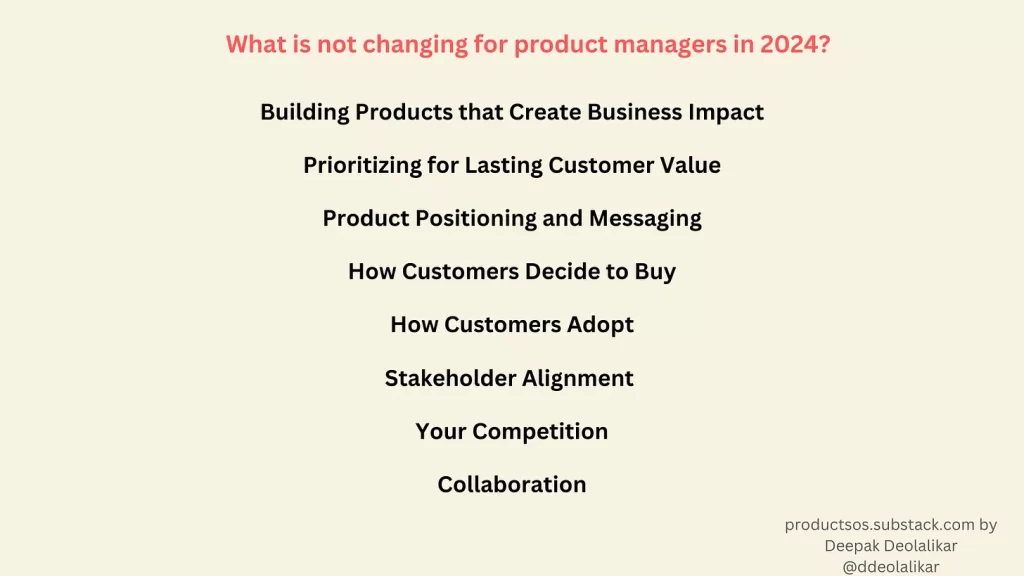Some universal truths for PMs
Hope you all had a wonderful Christmas with your family and friends.
This year, 2023, we witnessed significant changes. The economy, interest rate, inflation, unemployment had some significant swings. On the other hand, there were exciting new technologies, namely AI and LLM, that took our world by storm.
There were some who said that PMs are doomed as ChatGPT can write specs. Some others said ChatGPT will help the product managers do a better job.
What will happen only time will tell.
In a world where AI is making big changes, everyone’s talking about how product management is evolving. But let’s take a moment to look at the things that won’t change.
Despite all the talk about new technology, some important basics in product management will stay the same. In this blog post, we’ll steer away from the buzz about AI and focus on the essential things that will always be there. As we move into the future, these steady elements will be like a reliable guide for product managers in the midst of all the tech excitement.

Building Products that Create Business Impact
One unwavering truth persists: the ultimate goal is to build products that significantly contribute to business impact, whether in terms of revenue generation or customer retention. In 2024, as always, the core mission remains unchanged — products must be strategic assets that drive tangible value to the company.
Prioritizing for Lasting Customer Value
The fundamental principle guiding product prioritization endures: the focus must be on creating lasting customer value that translates into a tangible business impact. There are 100s of prioritization frameworks and more will be created. The ultimate goal for prioritization remains the same – ensuring that the chosen features align with customer needs and contribute meaningfully to the company’s success. You could use AI to help you summarize or arrange your feature sets, but you still need to make a judgement call.
Crafting Timeless Product Positioning
The way a product is positioned and messaged continues to hinge on how customers and the market perceive it. In 2024, product managers must remain attuned to these perceptions, adapting their positioning strategies to align with customer expectations and market dynamics.
How Customers Decide to Buy
The process of how customers evaluate and decide on the value of a product remains a timeless aspect of product management. In 2024, as in the past, delving into the intricacies of customer decision-making is essential for crafting offerings that resonate and meet the expectations of a discerning customer base.
How Customers Adopt
While technology advances, the challenge of getting customers to adopt a product remains a pivotal concern. Whether introducing innovative features or refining user experiences, product managers must continue to strategize on overcoming adoption barriers, removing friction, and ensuring that their offerings become an indispensable part of the customer’s toolkit.
Stakeholder Management and Alignment
Regardless of technological advancements, the art of managing and aligning stakeholders remains critical. In 2024, product managers must continue to secure buy-in and foster effective collaboration across diverse teams. The ability to navigate stakeholder dynamics ensures a unified approach toward achieving product success.
Your Competition
Competition is not fading away; on the contrary, it’s intensifying. As the cost of building diminishes and AI simplifies development, the SAAS landscape is becoming more crowded. In 2024, product managers must prepare for heightened competition, emphasizing innovation and differentiation to stay ahead.
Effective Collaboration with Engineers and Designers
Amid technological advancements, the core principles of working collaboratively with engineers and designers to create exceptional products remain constant. In 2024, as in the past, successful product management requires fostering effective collaboration, clear communication, and a shared vision among cross-functional teams.
The short conclusion of the above points is that all of these deal with two things that no technology will ever be able to change
Human minds
Resource constraints
The human mind will evolve but at a snails pace compared to these rapid technology advancements. Your product will certainly include the most cutting edge tech. But how customers think, how you react to competition, how you work with stakeholders will still need empathy and judgement.
And our resource constraints are not going to change overnight – budgets, manpower, materials, time. No amount of AI is going to make these resources abundant. So how you prioritize your work and create the right amount of product will be based on your cumulative experiences and judgment.
As a PM, don’t overlook the enduring importance of investing time in learning and mastering these critical aspects that bridge the gap between innovation and practical implementation.

